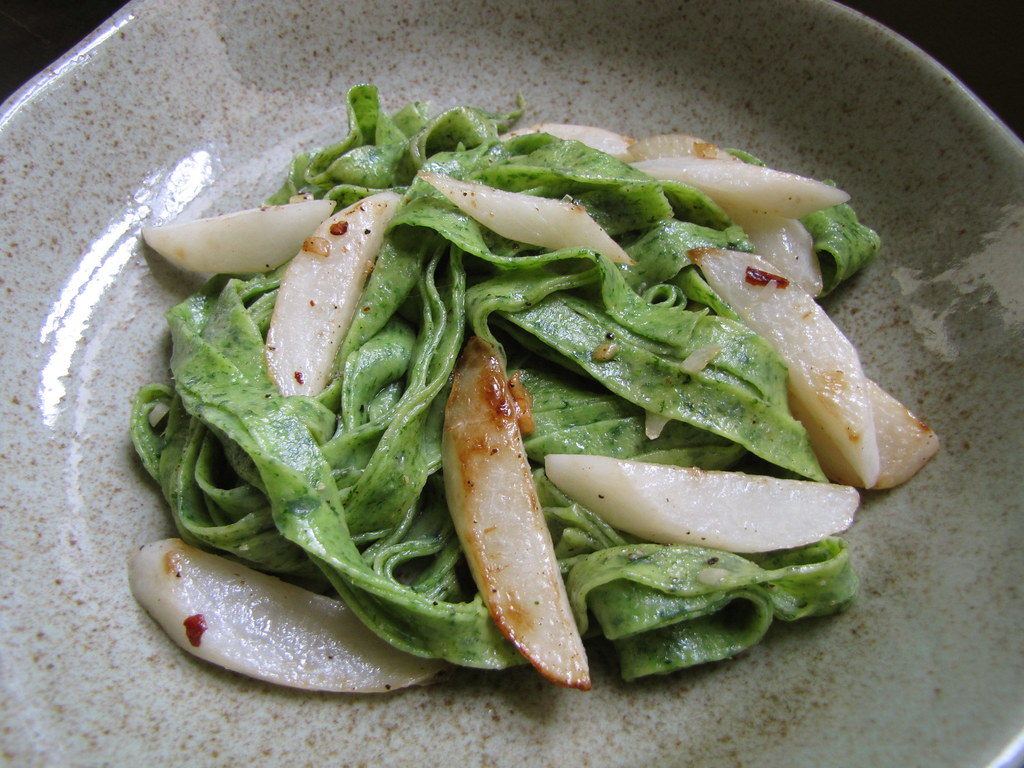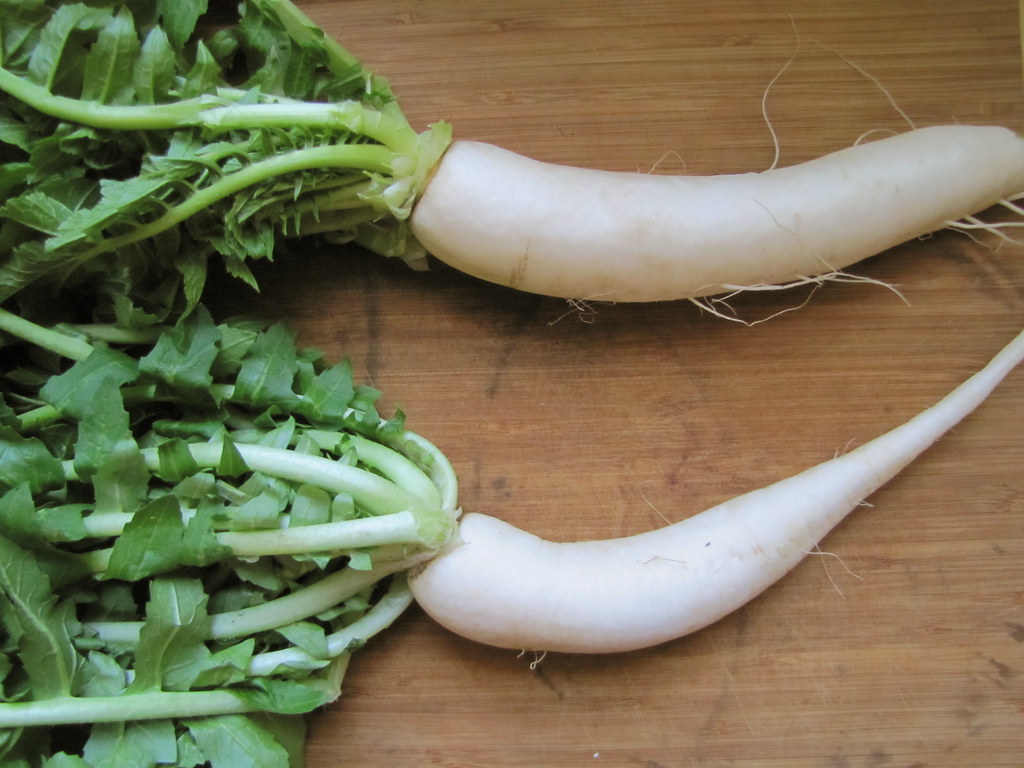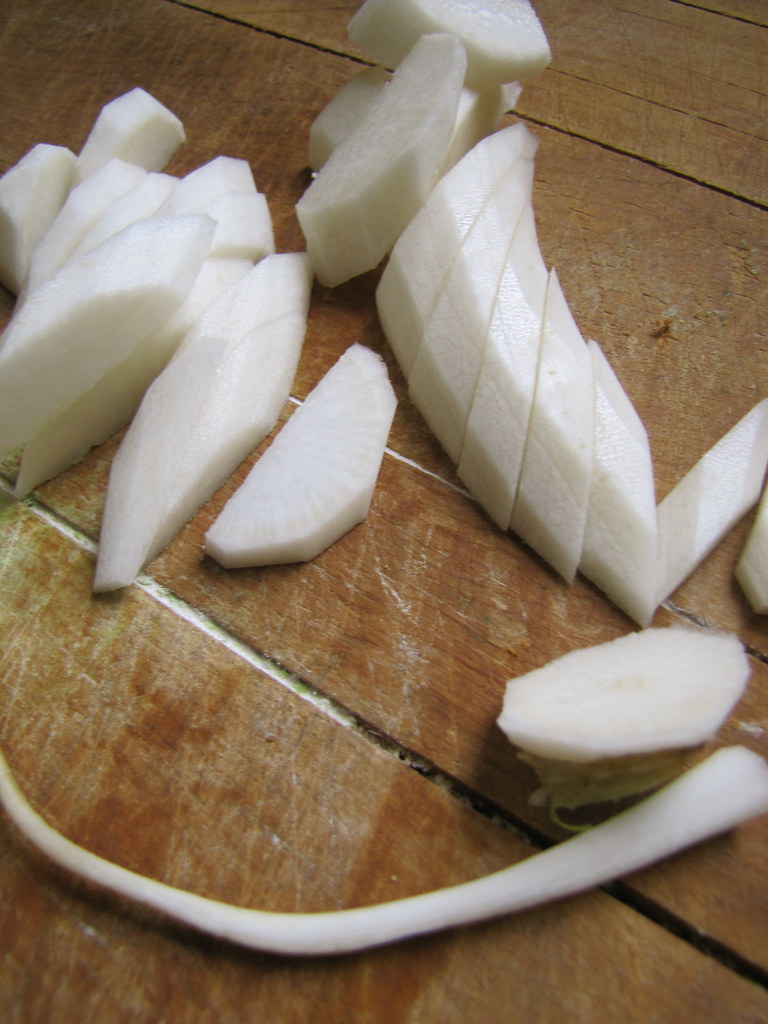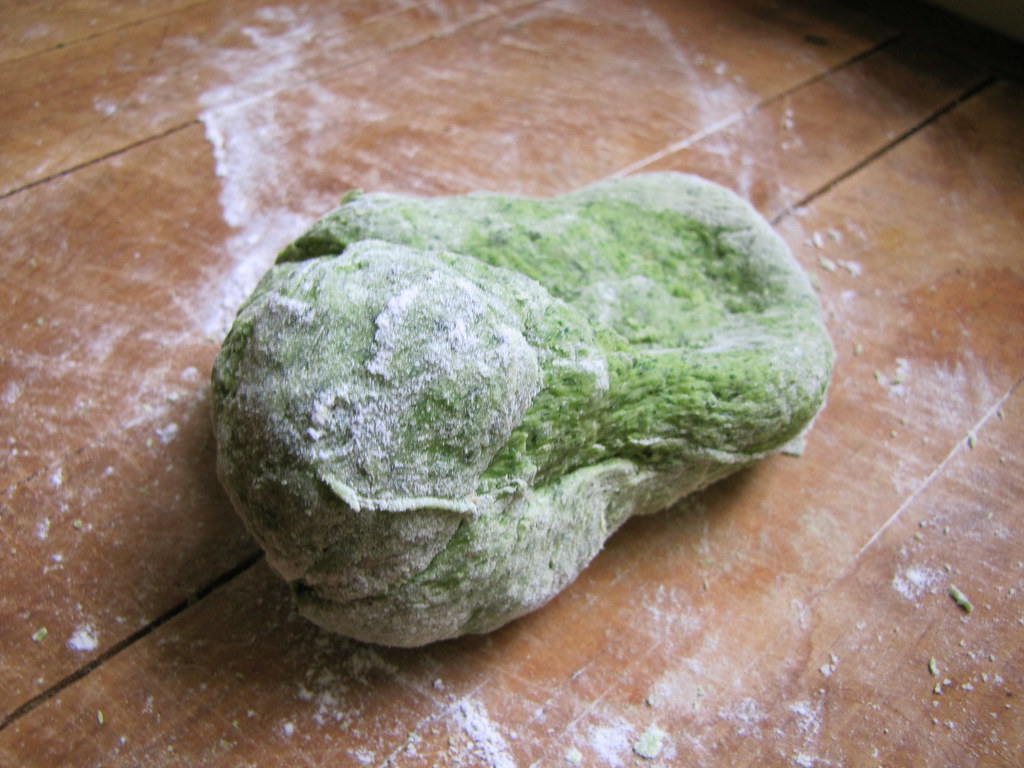
It’s another round of head-to-tail cooking, for the underrated root vegetable! And for good cause: radish greens are a true superfood, among the most nutrient-rich of all leafy greens, yet they tend to become a little coarse and bitter-tasting while the root beneath them matures. No matter — mash them into a silken fresh pasta to toss with the lightly cooked radishes, too.
I’d spotted these icicle-white daikon radishes with their tops still attached at the Union Square Greenmarket last week. And after a lifetime of only encountering these roots in Asian produce markets or restaurants, it was a revelation of sorts. The horn-shaped radishes were firm and porcelain, and the leafy green tops were bright green and bouncy — signs that they were recently picked.
 daikon radishes with their tops
daikon radishes with their tops
Such prime daikon radishes called for a better way to showcase them than fermenting as pickles or kimchi, or braising until soft. I wanted to taste what a fresh, plain daikon radish was like, and couldn’t think of too many instances when I actually had. My first was to sear them a little and sautee them in a simple pasta dish with some garlic, lemon juice and olive oil to enhance. But then we’d have white and off-white on the plate, which sounded pretty boring to the eye.
 the greens are blanched and shocked with ice
the greens are blanched and shocked with ice
 blended with an egg, and incorporated into flour
blended with an egg, and incorporated into flour
It’s less difficult than it looks, and making fresh pasta also becomes much easier once you’ve done it a couple times. You can easily add a pureed leafy green like spinach — or radish greens — in the first step. Just pick apart the leaves and blanch them for a few seconds in boiling water. An ice bath immediately afterward keeps its color a bright, healthy green. Squeeze it out, puree it well with a food blender (or just chop it up finely with your knife), and beat the eggs into it.
 fresh radish greens fettuccine
fresh radish greens fettuccine
The rest is just like making any other pasta. You can usually find the basic instructions with a pasta maker. Mine is an old Italian housewives’ Atlas pasta crank from the 70s, and they make plenty models just like it new. Which I might be investing in soon, because my fettuccine function isn’t cutting apart the noodles too well these days.
 the roots get chopped for a quick sautee
the roots get chopped for a quick sautee
You can’t taste the radish greens in the pasta too much, but they do make it a vibrant, Emerald City-green. Also, you’re getting lots of detoxins, since so much of the packed greens went in. This dish could easily be redone with fresh carrots and their delicate tops. But I was impressed with the subtle, spicy flavor and great snap of the fresh daikon roots in this dish. Cauliflower has just found a new fall rival.
Daikon Radish Greens Pasta with Seared Daikon Radishes
(makes 4 servings)
2 medium-sized daikon radishes with their leafy greens still attached
1 large egg
1 cup all-purpose flour
2 cloves garlic, minced
pinch of red pepper flakes
juice of about half of a lemon
2 tablespoons olive oil
1 tablespoon butter
salt and freshly ground black pepper to taste
Separate the radishes from their tops and strip the leaves from the stems. Bring a small pot of water to a boil and submerge the leaves. Remove after 30-45 seconds and transfer immediately to an ice bath to cool. Squeeze the leaves out and transfer to a food processor or blender. (Alternately, you can just chop them finely with a knife instead.) Add an egg to the food processor/blender to puree, stopping to scrape down the sides as necessary.
Place the flour in a bowl and make a well in the center. Pour the greens/egg mixture into the center and begin stirring it to let the flour gradually fall in from the sides. Continue doing this until all the flour has been incorporated. Dust a surface with flour and knead the dough for 8 minutes, until smooth. Cover with plastic and let sit for 15 minutes.
Peel the daikon radishes and halve lengthwise. Cut into about 1″ long pieces on a bias along the length of the radishes. Heat a large, wide pan with the olive oil and add the garlic and chile flakes over medium-high. Once hot, add the daikon pieces and don’t stir for the first minute or so to let them sear a little. Season with a pinch of salt and pepper. Reduce heat to medium (so garlic doesn’t burn) and cook, stirring occasionally, for another 2 minutes, or until pieces are more translucent but still crisp. Turn heat off until pasta is ready to add (see below).
Bring a large pot of salted water to a boil. Crank the pasta into thin sheets (I used the 6 level for thickness on my pasta crank) and then into pasta noodles of your choice (I chose fettuccine). When water is boiling, drop in the pasta at once and stir. Fresh pasta noodles need only cook about 2 minutes. Transfer the noodles immediately to the pan with radishes. Add the butter and lemon juice and toss to coat evenly. Taste for seasoning, adding salt and pepper as desired, and serve immediately.
Cost Calculator
(for 4 servings)
2 daikon radishes with their tops: $4.00
1 egg: $0.30
1 cup flour: $0.50
half a lemon: $0.20
1 tablespoon butter: $0.25
2 cloves garlic: $0.20
2 tablespoons olive oil, salt, pepper, chili flakes: $0.40
Total: $5.85
Health Factor![]()
![]()
![]()
Three brownie points: Radishes are one of the best things we’re not eating enough of. Daikon roots are a great detoxifier and are especially rich in potassium and copper, and they’re very low in calories. The greens bring in loads of Vitamin C and Vitamin K to your diet, as well as calcium and protein. With all that toxin and disease-fighting activity, a little richness from the egg pasta and butter can’t hurt much.
Green Factor![]()
![]()
![]()
![]()
![]()
![]()
![]()
![]()
Eight maple leaves: Using just one plant to create a hearty, full meal around is a good, green challenge — it reduces the chances that you’ll waste half-used bunches and parts of ingredients that are leftover, and you can be choosy about buying it from a responsible source. Using the greens as well as the roots of this “root vegetable” is a great way to make this work, and I might add that radishes are a very quick and easy to grow, low-impact plant, so let’s eat more of them anyway.

8 Responses
Raquel
Great post. Will be saving my radish greens from now on. Poor man’s arugula? Hmmmm.
Carol
So cool! Stumbled on this searching for “can I eat my daikon greens?” Thanks!
Ellen
This year we have expanded our 4 raised bed garden to 12 raised bed garden. My early planting of daikon was a success. I had a pail full of small daikon radishes (need to plant further apart next time) with greens. What was I going to do with all those greens?
Then I found your pasta recipe with Seared Daikon, Chilies, Garlic and Lemon (along with some pork meat cut into stew size pieces.
The pasta was incredibly good, as was the Seared Daikon, etc. topping. Thank you so very much for posting your creation. I will be using it with many of my garden greens from now on.
Blessings,
Ellen
Rita V
Lovely recipe, thanks. I used the pasta recipe as a starting point to make wrappers for gyoza stuffed with a pork and grated daikon filling. Delcious – thanks.
Another World
This post is invaluable. How can I find out more?
Look at my homepage … Another World
CHANEL
CHANEL
Daikon Radish Greens Pasta with Seared Daikon, Chilies, Garlic and Lemon » Not Eating Out in New York
Aoleon The Martian Girl Another World review
Aoleon The Martian Girl Another World review
Daikon Radish Greens Pasta with Seared Daikon, Chilies, Garlic and Lemon » Not Eating Out in New York
Penny C Dare
I had daikon leaves stir fry this morning. I made congee and ate it with the daikon leaves stir fry. Simple and good.
Pick daikon leaves from your veggie patch.. Wash and spin dry. Cut the stalks into 1 inch. Separate leaves and stalks.
Heat wok, add garlic and then stalks and fry. Then add leaves, salt and white pepper and red chili flakes. If you wish , add shitake mushrooms or sliced tofu. Delicious with rice or eat as appetizers. Enjoy.